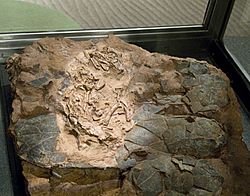Gigantoraptor facts for kids
Quick facts for kids GigantoraptorTemporal range: Upper Cretaceous
70 million years ago (mya) |
|
|---|---|
 |
|
| Embryo and eggs (Beibeilong) | |
| Scientific classification | |
| Kingdom: | |
| Class: | |
| Subclass: | |
| Superorder: | |
| Order: | |
| Suborder: | |
| Infraorder: | |
| Family: |
Caenagnathidae
|
| Genus: |
Gigantoraptor
|
| Synonyms | |
|
|
Gigantoraptor was a huge dinosaur that lived about 70 million years ago. It belonged to a group called oviraptorosaurs, which are a type of theropod dinosaur. This amazing creature was found in 2005 in Inner Mongolia, a region in China.
Contents
Discovery of Gigantoraptor
In 2005, a Chinese scientist named Xu Xing was filming a documentary. He was digging up bones of another dinosaur called Sonidosaurus. As he cleaned a thighbone, he realized it was not from Sonidosaurus. Instead, it belonged to a large, unknown meat-eating dinosaur.
This exciting moment was actually caught on camera! In 2007, Xu Xing and his team officially named this new dinosaur Gigantoraptor erlianensis. The name Gigantoraptor means "giant thief" or "giant raptor."
The first fossil found was a partial skeleton of a young adult Gigantoraptor. It included parts of its lower jaw, neck, back, tail, and legs. However, the skull was missing. This fossil helps us learn a lot about this unique dinosaur.
What Gigantoraptor Looked Like
Gigantoraptor was an incredibly large dinosaur. It was part of the Oviraptorosauria group, but it was much bigger than its relatives. For example, it was about three times longer and 35 times heavier than a smaller oviraptorosaur called Citipati.
Scientists believe Gigantoraptor was about 8 meters (26 feet) long. It likely weighed around 1,400 kilograms (3,086 pounds), which is more than a small car! Some estimates even suggest it could have weighed up to 2,000 kilograms (4,400 pounds).
Body Features
Gigantoraptor had a unique look. Its lower jaws were fused together and shaped like a broad shovel. Its skull, which would have been over half a meter long, probably had a strong, toothless beak, similar to a parrot's.
Its front limbs were quite long, with slender hands. The bones in its arms were curved outwards. Its first finger bone was very short, and it had a strong, spreading thumb. The back legs were also long, helping it move around. Its feet were strong, with large, curved claws on its toes.
Did Gigantoraptor Have Feathers?
No direct proof of feathers was found with the Gigantoraptor skeleton. However, many smaller oviraptorosaurs had feathers. Scientists think that very large animals like Gigantoraptor might not have needed a full coat of feathers for warmth. This is because their large size helps them keep warm.
Even without a full feathery coat, Gigantoraptor likely still had feathers on its arms. These arm feathers might have been used for showing off to other dinosaurs. They could also have been used to cover and protect its eggs while it was sitting on them.
Gigantoraptor Family Tree
When Gigantoraptor was first studied in 2007, scientists thought it belonged to the Oviraptoridae family. However, later studies in 2010 and beyond suggested it was actually part of a different but closely related group called the Caenagnathidae. This means it was a close cousin to dinosaurs in the Oviraptoridae family.
How Gigantoraptor Lived
Scientists are still not completely sure what Gigantoraptor ate. Some oviraptorosaurs, like Caudipteryx, were plant-eaters. But Gigantoraptor had long, fast-moving legs and big claws. These features are usually found in meat-eaters, not plant-eaters of its size.
One idea is that Gigantoraptor might have been a plant-eater that used its speed to escape from predators. Its large claws could have been used for defense or for digging up plants.
Growth and Life Cycle
The Gigantoraptor fossil found was about eleven years old when it died. Scientists could tell this by looking at its bones, which showed growth rings, much like tree rings. It seems to have grown very quickly, reaching a young adult stage by age seven.
This dinosaur probably would have grown even bigger if it had lived longer. Its fast growth rate was quicker than most other large meat-eating dinosaurs that were not birds.
Giant Eggs
The discovery of Gigantoraptor helped explain some very large dinosaur eggs found in Asia. These eggs were up to 53 centimeters (21 inches) long! They were laid in huge rings, sometimes three meters (10 feet) across. Before Gigantoraptor was found, scientists didn't know which dinosaur laid such enormous oviraptorosaur eggs. Now, we know it was likely Gigantoraptor or a similar giant oviraptorosaur.
Images for kids
-
A drawing of a Gigantoraptor pair protecting their nest from two Archaeornithomimus and an Alectrosaurus
See also
 In Spanish: Gigantoraptor erlianensis para niños
In Spanish: Gigantoraptor erlianensis para niños









